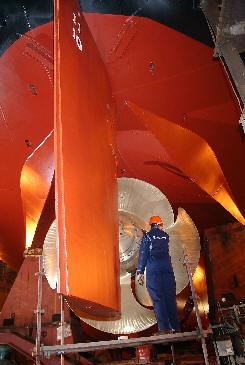 |
|
|
|
|
|
|||
|
By Daniel Baxter |
||||
 |
April 14, 2010 -
Rolls Royce, the global power systems company, has completed two
significant milestones for the Royal Navy’s new aircraft carriers, Queen
Elizabeth and Prince of Wales, with completion of the first propeller
and the successful testing of the vessels’ first MT30 gas turbine.
The propeller,
measuring almost seven metres in diameter and weighing 33 tons, has
completed acceptance tests at the Rolls-Royce facility in
The Kamewa
Adjustable Bolted Propeller is manufactured from nickel aluminum bronze
and features five blades mounted on a central hub – there will be two on
each of the aircraft carriers. Rolls-Royce is also supplying shaft lines which will link each of the vessels’ two propellers with the power source. Each propeller will deliver around 50,000 horse-power – the highest power Kamewa propeller ever developed by Rolls-Royce.
The first of four
MT30s for the two 65,000 ton vessels also passed a program of stringent
tests and certification at the Rolls-Royce Marine test facility, in |
|||
|
Rolls-Royce is
part of a ‘sub-alliance’ team comprising Thales, Converteam and L-3 and
has overall responsibility for delivery of the entire power and
propulsion system. “We are extremely proud to be involved in the development of these vessels, working alongside our many partners in the Aircraft Carrier Alliance to supply mission-critical technology and systems.” |
||||
|
Tony Graham, head
of Capital Ships at the Ministry of Defense, visited the
Matt Pollitt,
Rolls-Royce Test Integration and Support Manager and his team carried
out the MT30 test. He said: “The gas turbine performed as expected
during the tests, which simulated what you would see from the bridge of
the ship in a range of different sea conditions.
“We put the engine
through rigorous tests including what happens when the ship rapidly
demands either large amounts of power or large reductions in power due
to propulsion motor trips. The engine coped well with such extreme load
characteristics and I’m pleased to say it passed its Lloyd’s
certification too.”
The MT30 is the
most powerful available gas turbine in the marine market today and on
the carriers will form part of an integrated electric propulsion system
which includes the giant propellers and propeller shafts as well as
rudders, thrust bearings and low-voltage electrical systems.
1. Rolls-Royce, a
world-leading provider of power systems and services for use on land, at
sea and in the air, has established a strong position in global markets
- civil aerospace, defense aerospace, marine and energy.
2. As a result of
this strategy, Rolls-Royce today has a broad customer base comprising
more than 600 airlines, 4,000 corporate and utility aircraft and
helicopter operators, 160 armed forces, more than 2,000 marine
customers, including 70 navies, and energy customers in nearly 120
countries, with an installed base of 54,000 gas turbines.
3. Rolls-Royce
employs over 38,000 skilled people in offices, manufacturing and service
facilities in 50 countries. The Group has a strong commitment to
apprentice and graduate recruitment, and to further developing employee
skills.
4. In 2009,
Rolls-Royce invested £864 million on research and development, two
thirds of which had the objective of further improving the environmental
aspects of its products, in particular the reduction of emissions.
5. Annual
underlying revenues were £10.1 billion in 2009, of which about half came
from services revenues. The firm and announced order book stood at £58.3
billion at 31 December 2009, providing visibility of future levels of
activity.
6. The Marine
business of Rolls-Royce employs 8,000 people in 34 countries with the
main manufacturing centres being in the UK, the Nordic countries, the
United States and increasingly Asia.
7. Rolls-Royce is
a world leader in marine solutions, providing products, service and
expertise to more than 30,000 vessels in the offshore, merchant, naval
surface and submarine markets. It designs ships and its product range
includes propulsion systems featuring diesel engines and gas turbines,
propellers, thrusters and water jets. Rolls-Royce also provides
maneuvering and stabilizing systems and deck machinery. Around 30 per
cent of Marine turnover is derived from service support activity, with a
global network of sales and service offices in 34 countries. Rolls-Royce
equipment is in service with more than 70 navies.
8. The Power and
Propulsion Sub-Alliance comprises of Thales
9. The Aircraft
Carrier
10. Rolls-Royce
continues to invest in core technologies, products, people and
capabilities with the objective of broadening and strengthening the
product portfolio, improving efficiency and enhancing the environmental
performance of its products. |
| ©AvStop
Online Magazine
Contact
Us
Return To News
|
|
